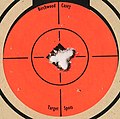This article needs additional citations for verification .(June 2023) |



Shooting targets are objects in various forms and shapes that are used for pistol, rifle, shotgun and other shooting sports, as well as in darts, target archery, crossbow shooting and other non-firearm related sports. The center is often called the bullseye. Targets can for instance be made of paper, "self healing" rubber or steel. There are also electronic targets that electronically can provide the shooter with precise feedback of the shot placement.
Contents
- History
- Types of targets
- by Action
- by Reactivity
- by Material
- by Realism
- by Color
- Archery sports
- World Archery Federation
- 3D archery targets
- Dart
- Firearm sports
- Air rifle field targets
- Clay pigeons
- International Confederation of Fullbore Rifle Associations
- International Practical Shooting Confederation
- International Shooting Sport Federation
- Metallic silhouette
- Popinjays
- Human silhouette
- Mannequins
- See also
- References
- External links





















































